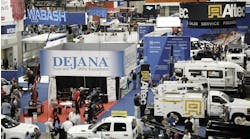Latest from Home
Work Truck Week 2025 Welcomes More Than 16,000
Sponsored
WASHINGTON — Making a commitment to utilize green technologies and alternative energy at the federal level, President Barack Obama issued the Federal Leadership in Environmental, Energy and Economic Performance Executive Order this October, setting sustainable goals for federal agencies, and also announced a $3.4 billion investment in a smart energy grid.
“As the largest consumer of energy in the U.S. economy, the federal government can and should lead by example when it comes to creating innovative ways to reduce greenhouse gas emissions, increase energy efficiency, conserve water, reduce waste, and use environmentally-responsible products and technologies,” said Obama. “This Executive Order builds on the momentum of the Recovery Act to help create a clean energy economy and demonstrates the federal government's commitment, over and above what is already being done, to reducing emissions and saving money.”
The Federal Leadership in Environmental, Energy and Economic Performance EO requires federal agencies to increase energy efficiency, conserve water, support sustainable communities, and leverage federal purchasing power to promote sustainable products and technologies, among other requirements. Since the federal government occupies nearly 500,000 buildings, operates more than 600,000 vehicles, employs more than 1.8 million civilians, and purchases more than $500 billion per year in goods and services, it's likely that this EO will affect contractors, bidding on federal government projects and servicing federal buildings.
“The Executive Order issued by President Obama is another step in the right direction for this country and for our industry,” said Mechanical Contractors Association of America (MCAA) President Lonnie Coleman. “Two years ago President Bush started moving the federal government toward more energy-efficient facilities, and President Obama has now expanded these efforts. Whether you want this country to be energy independent or want to mitigate climate change or both, that's a good thing.”
The EO describes a process by which agency goals will be set and reported to Obama by the Chair of the Council on Environmental Quality. Agency targets include a 26% improvement in water efficiency by 2020 and implementation of the 2030 net-zero energy building requirement, plus, 95% of all applicable contracts will need to meet sustainability requirements.
According to the EO, water efficiency will be increased by reducing potable water consumption by implementing water management strategies, including the use of water-efficient and low-flow fixtures, and efficient cooling towers, along with other water conservation and reuse strategies.
The EO also notes that high-performance sustainable federal building design, construction, operation, management, maintenance and deconstruction will be implemented by ensuring that all new federal buildings will achieve zero-net energy by 2030 (starting in 2020); all new construction, major renovation, or repair and alteration of a building complies with the Guiding Principles for Federal Leadership in High Performance and Sustainable Buildings; and 15% of an agency's existing and leased buildings above 5,000-sq.ft. meet the Guiding Principles by 2015 and make progress towards conforming to the principles.
“As contractors, MCAA members have been working in this area longer than most,” said Coleman. “We've trained over 1,000 of our members to become LEED Accredited Professionals, we've held Webinars, we've worked with our manufacturer and supplier members, and we've done a number of green projects to date. We're excited to see the federal government prioritizing this important work.”
Agencies will also need to manage existing building systems to reduce energy consumption, water consumption, materials consumption, and identify alternatives to renovations, reducing deferred maintenances costs, according to the EO.
“Our retro-commissioning and energy audit seminars directly address the Executive Order's call for increased efficiency and stewardship,” said Barbara Dolim, executive director of the Mechanical Service Contractors of America, an MCAA subsidiary. “There are about a half million buildings leased or owned by the federal government. Many of our members already service systems in these buildings and in other public buildings where states and local governments have established similar guidelines, or are planning them. Because of the nature of service, members are keeping themselves current on cutting-edge solutions to problems.”
Contracts have already been awarded to build sustainable federal facilities. The U.S. Department of Veterans Affairs National Energy Business Center has been awarded a design-build contract for a wind turbine electric generation system to serve its Medical Center in St. Cloud, Minn., and the U.S. General Services Administration's Denver Federal Center in Lakewood, Colo., will install a photovoltaic system as part of a modernization project.
Besides setting sustainable goals for federal agencies, Obama also announced a $3.4 billion investment to transition to a smart energy grid, which will fund alternative technologies, such as wind and solar. As part of the American Reinvestment and Recovery Act, the investment will be matched by industry funding for a total public-private investment worth more than $8 billion.
Transitioning to a smart grid will increase the efficiency, reliability and security of the system, and link energy resources with the electric grid, plus, transfer energy from alternative sources farther distances. The investment will allow more than 1 million in-home displays, 170,000 smart thermostats, and 175,000 other load control devices to be installed, so consumers can reduce energy use, putting the U.S. on a path to get 20% or more of its energy from renewable sources by 2020.
Candace Roulo
Candace Roulo, senior editor of CONTRACTOR and graduate of Michigan State University’s College of Communication Arts & Sciences, has 15 years of industry experience in the media and construction industries. She covers a variety of mechanical contracting topics, from sustainable construction practices and policy issues affecting contractors to continuing education for industry professionals and the best business practices that contractors can implement to run successful businesses.

